-
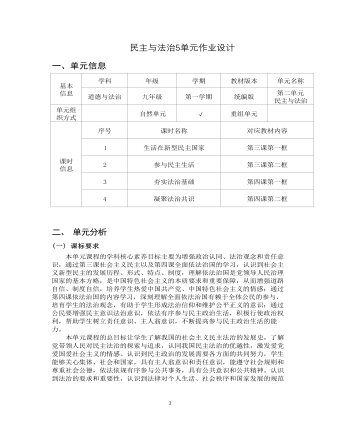
九年级上册道德与法治民主与法治5作业设计
①政府的宗旨是全心全意为人民服务②政府要坚持依法行政,努力建设法治政府③行政机关要保障公民的知情权、参与权、表达权、监督权④人民可以随心所欲地点评政府的工作A. ①②④ B. ②③④ C. ①②③ D. ①③④9. 在道德与法治课堂上,赵老师为大家展示了下列案例,同学们对此作出了解 读。其中正确的有( )①市人大常委会召开立法听证会-科学立法②刘某经营餐馆却没有办理营业执照-全民守法③执法机关检查疫苗企业生产经营状况-严格执法④人民法院在审理案件时进行庭审直播-公正司法A. ①②③ B. ①③④ C. ①②④ D. ②③④10. 某校学生以“全民守法,中学生在行动”为主题开展了法治情景剧 、法治海 报、模拟法庭等活动。这些活动加深了学生们对法律的认识, 提高了学生们的法 律意识。下列选项中,中学生应该做的是( )①看到有人跌倒立即上前帮助 ②利用假期到社区清除小广告③努力为法治中国建设贡献力量 ④敢于并善于同违法犯罪行为作斗争A. ①② B. ②③ C.②④ D. ③④
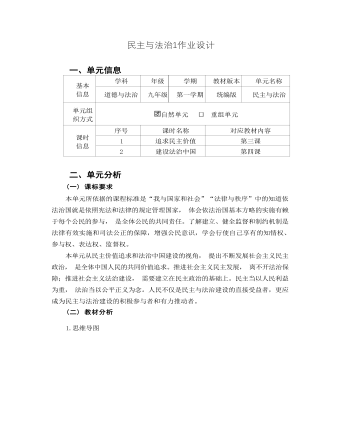
九年级上册道德与法治民主与法治1作业设计
2.认同民主是具体的, 能够根据本国的国情看待民主实现的方式, 积极主动 参与民主生活,培育民主意识,形式民主权利。3.体会法治在社会中的作用, 认同法治价值观, 感受法治中国的进步, 坚定 走中国特色社会主义法治道路的信念。4.感受见识法治中国是全体社会成员的共同责任, 并树立法治意识, 自觉尊 法学法守法用法,践行法治精神。四、单元作业设计思路(一) 单元作业设计基本原则1.作业设计应全面地反映知识与技能、过程与方法、情感与价值这个三维目 标。在有效作业设计中, 应重视教材学习材料的深度挖掘编写出相应题目, 以促 进学生从课堂学习中获取必要的认识经验, 通过过程获得感受, 通过活动得到一 定的体会,通过探索得一些感悟。2.作业设计应考虑学生的参与度。分层设计, 让不同层次的学生有选择地训 练,可有效地避免不做练习或抄作业现象,大大提高学生的参与度。3.控制作业的时间限度, 少时高效。控制课后作业时间, 关注学生身心健康, 促进学生全面发展。
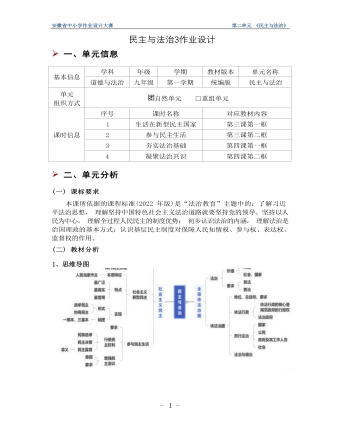
九年级上册道德与法治民主与法治3作业设计
(三) 学情分析初中阶段的学生正处在世界观、人生观、价值观形成的关键时期, 加强对这 一年龄段学生的法治教育尤为重要。随着学生生活范围的延展和能力的提升, 本课程的学习逐步扩展到国家和社 会。从生活经验看, 大部分中学生有参与班干竞选、给班级或学校提建议的经验。 从知识储备看, 学生在八年级下册已经学习了我国的根本政治制度、基本政治制 度, 故学习本课知识已经具备了一定的理论基础。但如何理解民主, 还需要通过 不断的学习来建立认同。另外七八年级也打下了一定的法律基础, 学生已经初步 了解个人的成长和参与社会生活必备的基本法律常识。本单元第三课通过介绍社会主义民主制度的确立过程, 中国特色社会主义民 主的本质和实现方式, 引领学生理解社会、参与公共生活, 帮助学生认同民主的 价值,引导学生做负责任的公民。第四课阐释法治是什么、回顾法治中国的历程、 明确为什么选择中国特色社会主义法治道路、怎样建设法治中国及初中生在法治 中国的建设中应扮演怎么样的角色等问题, 帮助学生认识法治中国的进程, 引导 学生正确看待法治中国建设进程中出现或可能出现的问题, 进而把法治作为基本 的生活方式,在实践中培育法治观念。
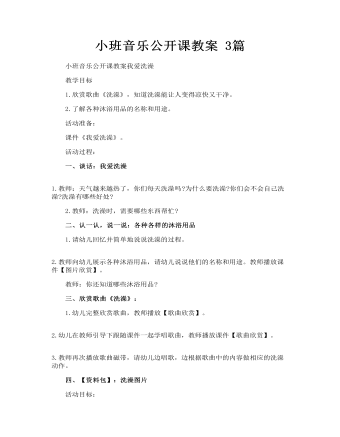
小班音乐公开课教案 3篇
一、谈话:我爱洗澡 1.教师:天气越来越热了,你们每天洗澡吗?为什么要洗澡?你们会不会自己洗澡?洗澡有哪些好处? 2.教师:洗澡时,需要哪些东西帮忙? 二、认一认,说一说:各种各样的沐浴用品 1.请幼儿回忆并简单地说说洗澡的过程。 2.教师向幼儿展示各种沐浴用品,请幼儿说说他们的名称和用途。教师播放课件【图片欣赏】。 教师:你还知道哪些沐浴用品?
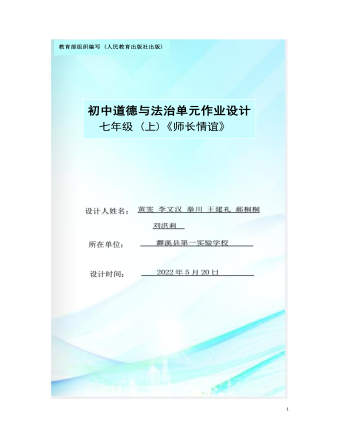
初中道德与法治七年级上册师长情谊2作业设计
本单元内容是部编版《道德与法治》七年级上册第三单元,单元标题是“师 长情谊”,依据《义务教育道德与法治课程标准 (2022 年版) 》,围绕核心素 养确定的课程目标要求如下:1、道德修养家庭美德,践行以尊老爱幼、男女平等、勤劳节俭、邻里互助为主要内容的 道德要求,做家庭好成员。培育学生的道德修养,有助于他们经历从感性体验到理性认知的过程,传承 中华民族传统美德,形成健全的道德认知和道德情感,发展良好的道德行为。 2、健全人格理性平和,开放包容,理性表达意见,能够换位思考,学会处理与家庭、他 人的关系。3、总目标学生能够了解个人生活和公共生活中基本的道德要求和行为规范,能够在日常生 活中践行尊老爱幼等的道德要求;形成初步的道德认知和判断,能够明辨是非善 恶;通过体验、认知和践行,形成良好的道德品质。具有理性平和的心态,能够 建立良好的师生关系和家庭关系。
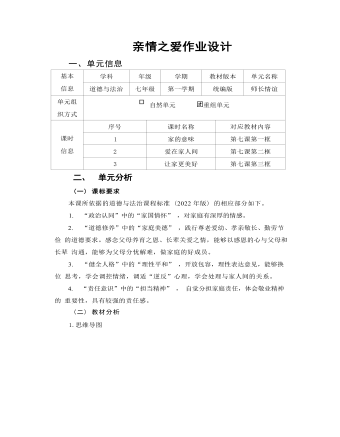
初中道德与法治七年级上册亲情之爱2作业设计
(一) 课标要求本课所依据的道德与法治课程标准 (2022 年版) 的相应部分如下。1. “政治认同”中的“家国情怀” ,对家庭有深厚的情感。2. “道德修养”中的“家庭美德” ,践行尊老爱幼、孝亲敬长、勤劳节俭 的道德要求。感念父母养育之恩、长辈关爱之情,能够以感恩的心与父母和长辈 沟通,能够为父母分忧解难,做家庭的好成员。3. “健全人格”中的“理性平和” ,开放包容,理性表达意见,能够换位 思考,学会调控情绪,调适“逆反”心理,学会处理与家人间的关系。4. “责任意识”中的“担当精神” , 自觉分担家庭责任,体会敬业精神的 重要性,具有较强的责任感。(二) 教材分析1.思维导图2. 内容内在逻辑第七课《亲情之爱》是七年级上册第三单元第二部分内容。在介绍与同学、 朋友、老师交往的基础上,要求学生认识、了解家庭,学会与家人交往。
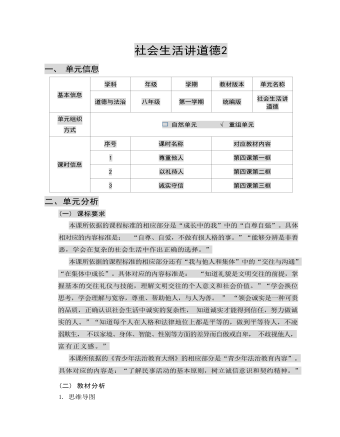
道德与法治八年级上册社会生活讲道德2作业设计
(一) 课标要求本课所依据的课程标准的相应部分是“成长中的我”中的“自尊自强”。具体 相对应的内容标准是: “自尊、自爱,不做有损人格的事。”“能够分辨是非善 恶,学会在复杂的社会生活中作出正确的选择。”本课所依据的课程标准的相应部分还有“我与他人和集体”中的“交往与沟通” “在集体中成长”。具体对应的内容标准是: “知道礼貌是文明交往的前提,掌 握基本的交往礼仪与技能,理解文明交往的个人意义和社会价值。”“学会换位 思考,学会理解与宽容,尊重、帮助他人,与人为善。 ” “领会诚实是一种可贵 的品质,正确认识社会生活中诚实的复杂性, 知道诚实才能得到信任,努力做诚 实的人。”“知道每个人在人格和法律地位上都是平等的,做到平等待人,不凌 弱欺生, 不以家境、身体、智能、性别等方面的差异而自傲或自卑, 不歧视他人, 富有正义感。”
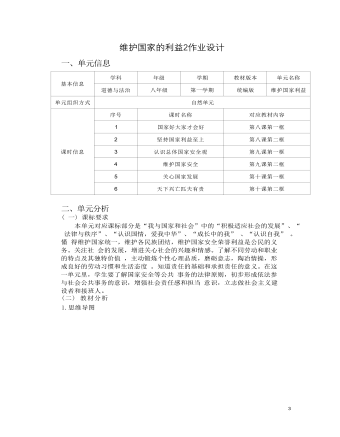
道德与法治八年级上册维护国家利益2作业设计
2. 内容内在逻辑第八课《国家利益至上》设计了“国家好,大家才会好”“坚持国家利益至 上”两框内容,其立意在于帮助学生认识维护国家利益的重要性,正确认识国家 利益与人民利益的关系,提高维护国家利益的意识,树立正确的国家利益管,提 高辨析各种爱国观念和行为的能力,使自己的爱国情感更加理性、深沉。第九课《树立总体国家安全观》设计了“认识总体国家安全观”和“维护国 家安全”两框。 目的在于引导学生正确理解和全面把握我国安全形势面临的挑战 ,从小树立总体国家安全观, 自觉担负起维护国家安全的责任。第十课《建设美好祖国》设计了“关心国家发展”“天下兴亡,匹夫有责” 两框内容,其目的和意图在于帮助学生全面认识国家发展,从初中学生的角度认 识祖国发展,正视国家发展过程中的问题,理解自己与国家发展的密切关联,让 学生在关心祖国发展的同时,为将来投身于国家建设奠定认识基础。
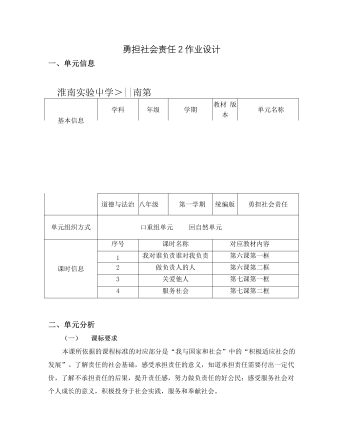
道德与法治八年级上册勇担社会责任2作业设计
一、单项选择题1. 假如你选择当一名教师,那便意味着你要教书育人;假如你选择做一名军人,那便意味着你要保家卫国;假如……这说明( )A. 我们可以根据需要选择承担或不承担责任B. 不同的角色要求承担不同的责任C. 责任对于每个人都是负担D. 每个人都应该承担相同的责任2. 芝加哥自然历史博物馆的卡尔?施密特在观察一条毒蛇时,突然遭其袭击,他顿时感到头晕,想要打电话,却发现电话坏了。他知道自己一定会死,但他坐 在桌前,记录自己死前的感受。卡尔在生命最后一刻默默守着工作岗位的举动, 表明( )A. 一个人无论什么时期都应对自己的一生负责B. 每个人在一生中所担负的责任往往是多重的C. 有知识和能力才能为社会贡献他的聪明才智D. 勇敢地承担责任首先要有强烈的责任意识
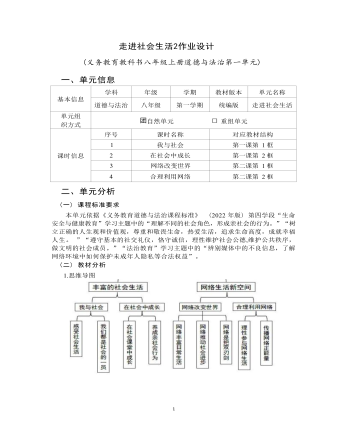
道德与法治八年级上册走进社会生活2作业设计
情景一 :小明发现利用手机不仅可以查阅资料 、学习新知 、广交朋友, 还可以聊微信 、 刷抖音 、 玩游戏 。 小明感叹: 一机在手 , 天 下我有!情景二: 在使用过程中 , 小明还发现 , 广告插件无处不在 , 明星八卦 扑面而来 , 各种信息真假难辨 。 游曳在五光十色的网海里 , 小 明 经 常 旷 课 , 成 绩 不 断 下 滑 , 越 来 越 不 愿 与 人 打 交 道 , 经 常宅在家里 ,沉迷游戏 ,最后还因为在网络上诈骗而被拘留。小明再一次感叹: 一机在手 , 毁我所有!请你根据情景,结合所学 内容 , 回答下列问题:(1)两 则材料共 同说 明了什 么? 请谈谈你对 “ 一机在手 , 毁我所有 ” 的理解 。 (6 分)(2)对 比两则材料 , 你 能得 到 哪些启示? (三个方面 即可 ) (6 分)【心系社会 公益有我】12. ( 18 分 ) “海 阔凭鱼跃 ,天 高任鸟飞 。 ”置 身于前所未有 的广 阔天地, 我们要主动融入绚丽多彩的社会生活 ,树立积极的生活态度 ,学会互 助关爱 、合作共享 ,承担起我们作为社会成 员的 责任 。某校八 (1) 班 同学在团支部带领下,开展了以“心系社会 · 公益有我”为主题的探究性学 习活动,请你参与并完成下列任务。
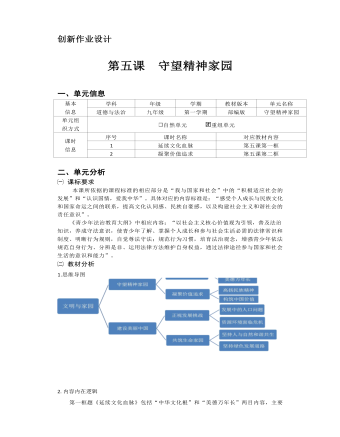
九年级上册道德与法治守望精神家园2作业设计
2. 内容内在逻辑第一框题《延续文化血脉》包括“中华文化根”和“美德万年长”两目内容,主要阐述了中华优秀传统文化是中华民族的根,中华传统美德是中华文化的精髓。第一 目侧 重从中华文化的丰富与发展角度,讲述中华民族在五千多年文明发展中孕育、创造的源 远流长、博大精深的中华文化,重点落在“中国特色社会主义文化积淀着中华民族最深 层的精神追求,代表着中华民族独特的精神标识,为中华民族伟大复兴提供精神动力”, 我们要坚定文化自信。第二目侧重从代代传承的中华美德角度,阐释中华传统美德的丰 富内涵和重要价值,重点落在“中华传统美德是中华文化的精髓,蕴含着丰富的道德资 源,是建设富强民主文明和谐美丽的社会主义现代化强国的精神力量”。第二框《凝聚价值追求》学生在前一框题学习了中华文化的作用与发展,增强了文 化自信心;学习了中华美德的内涵及影响,明白了美德的力量在践行。
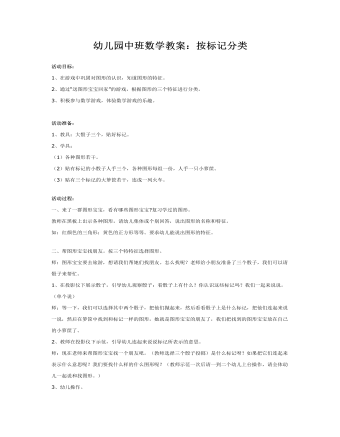
幼儿园中班数学教案:按标记分类
2、通过“送图形宝宝回家”的游戏,根据图形的三个特征进行分类。 3、积极参与数学游戏,体验数学游戏的乐趣。 活动准备: 1、教具:大骰子三个,贴好标记。 2、学具: (1)各种图形若干。 (2)贴有标记的小骰子人手三个,各种图形每组一份,人手一只小箩筐。 (3)贴有三个标记的大箩筐若干,连成一列火车。 活动过程: 一、来了一群图形宝宝,看有哪些图形宝宝?复习学过的图形。 教师在黑板上出示各种图形,请幼儿集体或个别回答,说出图形的名称和特征。 如:红颜色的三角形;黄色的正方形等等。要求幼儿能说出图形的特征。 二、帮图形宝宝找朋友。按三个特特征选择图形。 师:图形宝宝要去旅游,想请我们帮她们找朋友。怎么找呢?老师给小朋友准备了三个骰子,我们可以请骰子来帮忙。

新人教版高中英语必修3Unit 1 Festivals and Celebrations教学设计二
1. Ss look at the picture and scan the passage to understand the main idea while teacher is giving the following questions to inspire Ss to think.*Where are those people?*What are they doing?*Why are they so excited?2. Ss complete the passage with the appropriate -ing form. Then discuss and check the answers with class.Answers: boring, interesting, taking, exciting, amazing3. The teacher raises questions for the students to discuss and encourages them to express their opinions.*Do you like La Tomatina? Why or why not?4. Each group representative reports the discussion result, the teacher gives feedback and the evaluation.Step 6 PracticeActivity 41. Ss complete the Ex 2 in Using structures.2. Check the answers after finishing the exercises.①The dragon boat races are the most exciting part of the Dragon Boat Festival.② The children were excited to go Easter egg hunting.③What an amazing performance! This is the best music festival I have ever been to.④We were amazed by her funny-looking hat.⑤His inspiring speech at the conference won the admiration/ favour of the audience.⑥This is a challenging game to test your memory and observation capabilities. 3. T asks Ss to finish Ex 3 and 4 in Using structures by themselves, then check the answers with class.Step 6 Homework1. Understand and master the functions and usage of the -ing form;2. Finish the other exercises in Using structures.1、通过本节内容学习,学生是否理解和掌握动词-ing形式作定语和表语的功能和意义;2、通过本节内容学习,学生能否在理解文段内容的基础上,根据上下文语境和表达逻辑,能正确运用动词-ing形式描述节日庆典。3、通过本节内容学习,学生是否归纳和积累用于表达情绪的相关词汇。

新人教版高中英语必修3Unit 1 Festivals and Celebrations教学设计三
*wide range of origins(= a great number of different origins, many kinds of origins)*It featured a parade and a great feast with music, dancing, and sports. (=A parade and a great feast with music, dancing, and sports were included as important parts of the Egyptian harvest festival.)*.. some traditions may fade away and others may be established.(= Some traditions may disappear gradually, while other new traditions may come into being.)Step 6 Practice(1) Listen and follow the tape.The teacher may remind the students to pay attention to the meaning and usage of the black words in the context, so as to prepare for the completion of the blanks in activity 5 and vocabulary exercises in the exercise book.(2) Students complete the text of activity 5 by themselves.The teacher needs to remind the students to fill in the blanks with the correct form of the vocabulary they have learned in the text.Students exchange their answers with their partners, and then teachers and students check their answers.(3)Finish the Ex in Activity 5 of students’ book.Step 7 Homework1. Read the text again, in-depth understanding of the text;2. Discuss the origin of festivals, the historical changes of related customs, the influence of commercial society on festivals and the connotation and essential meaning of festivals.3. Complete relevant exercises in the guide plan.1、通过本节内容学习,学生是否理解和掌握阅读文本中的新词汇的意义与用法;2、通过本节内容学习,学生能否结合文本特点快速而准确地找到主题句;3、通过本节内容学习,学生能否理清论说文的语篇结构和文本逻辑,了解节日风俗发展与变迁,感悟节日的内涵与意义。

新人教版高中英语必修3Unit 3 Diverse Cultures教学设计一
Activity 81.Grasp the main idea of the listening.Listen to the tape and answer the following questions:Who are the two speakers in the listening? What is their relationship?What is the main idea of the first part of the listening? How about the second part?2.Complete the passage.Ask the students to quickly review the summaries of the two listening materials in activity 2. Then play the recording for the second time.Ask them to complete the passage and fill in the blanks.3.Play the recording again and ask the students to use the structure diagram to comb the information structure in the listening.(While listening, take notes. Capture key information quickly and accurately.)Step 8 Talking Activity 91.Focus on the listening text.Listen to the students and listen to the tape. Let them understand the attitudes of Wu Yue and Justin in the conversation.How does Wu Yue feel about Chinese minority cultures?What does Justin think of the Miao and Dong cultures?How do you know that?2.learn functional items that express concerns.Ask students to focus on the expressions listed in activity. 3.And try to analyze the meaning they convey, including praise (Super!).Agree (Exactly!)"(You're kidding.!)Tell me more about it. Tell me more about it.For example, "Yeah Sure." "Definitely!" "Certainly!" "No kidding!" "No wonder!" and so on.4.Ask the students to have conversations in small groups, acting as Jsim and his friends.Justin shares his travels in Guizhou with friends and his thoughts;Justin's friends should give appropriate feedback, express their interest in relevant information, and ask for information when necessary.In order to enrich the dialogue, teachers can expand and supplement the introduction of Miao, dong, Lusheng and Dong Dage.After the group practice, the teacher can choose several groups of students to show, and let the rest of the students listen carefully, after listening to the best performance of the group, and give at least two reasons.

新人教版高中英语必修3Unit 1 Festivals and Celebrations教学设计一
本板块的活动主题是“谈论节日活动”(Talk about festival activities),主要是从贴近学生日常生活的角度来切入“节日”主题。学生会听到发生在三个国家不同节日场景下的简短对话,对话中的人们正在参与或将要亲历不同的庆祝活动。随着全球化的进程加速,国际交流日益频繁,无论是国人走出国门还是外国友人访问中国,都已成为司空见惯的事情。因此,该板块所选取的三个典型节日场景都是属于跨文化交际语境,不仅每组对话中的人物来自不同的文化背景,对话者的身份和关系也不尽相同。1. Master the new words related to holiday: the lantern, Carnival, costume, dress(sb)up, march, congratulation, congratulate, riddle, ceremony, samba, make - up, after all. 2. To understand the origin of major world festivals and the activities held to celebrate them and the significance of these activities;3. Improve listening comprehension and oral expression of the topic by listening and talking about traditional festivals around the world;4. Improve my understanding of the topic by watching pictures and videos about different traditional festivals around the world;5. Review the common assimilation phenomenon in English phonetics, can distinguish the assimilated phonemes in the natural language flow, and consciously use the assimilation skill in oral expression. Importance:1. Guide students to pay attention to the attitude of the speaker in the process of listening, and identify the relationship between the characters;2. Inspire students to use topic words to describe the festival activities based on their background knowledge. Difficulties:In the process of listening to the correct understanding of the speaker's attitude, accurately identify the relationship between the characters.

新人教版高中英语必修3Unit 3 Diverse Cultures教学设计三
The price is the same as(the price was)before the war.价格与战前相同。(4)定语从句中的“关系代词+助动词be”可以省略。The ticket(that/which was)booked by his sister has been sent to him.他妹妹订的那张票已送到了他那里。Step 5 PracticeActivity 3(1) Guide students to complete the four activities in the Using Structures part of exercise book, in which activities 1 and 2 focus on ellipsis in dialogue answers, activity 3 focus on signs and headlines, two typical situations where ellipsis is used, and activity 4 focus on ellipsis in diary, an informal style.(2) Combine the examples in the above activities, ask students to summarize the omitted situations in groups, and make their own summary into a poster, and post it on the class wall after class to share with the class.(This step should give full play to the subjectivity of students, and teachers should encourage students to conclude different ellipsis phenomena according to their own understanding, they can conclude according to the different parts omitted in the sentence.)Step 6 Homework1. Understand and master the usages of ellipsis;2. Finish the other exercises in Using structures of Workbook.1、通过本节内容学习,学生是否理解和掌握省略的用法;2、通过本节内容学习,学生能否根据上下文语境或情景恢复句子中省略的成分,体会使用省略的效果;3、通过本节内容学习,学生能否独立完成练习册和导学案中的相关练习。

新人教版高中英语必修3Unit 3 Diverse Cultures教学设计二
(2)Consolidate key vocabulary.Ask the students to complete the exercises of activity 6 by themselves. Then ask them to check the answers with their partners.(The first language:Damage of the 1906 San Francisco earthquake and fire.A second language: Yunnan - one of the most diverse provinces in China).Step 5 Language points1. The teacher asks the students to read the text carefully, find out the more words and long and difficult sentences in the text and draw lines, understand the use of vocabulary, and analyze the structure of long and difficult sentences.2. The teacher explains and summarizes the usage of core vocabulary and asks the students to take notes.3. The teacher analyzes and explains the long and difficult sentences that the students don't understand, so that the students can understand them better.Step 6 Homework1. Read the text again, in-depth understanding of the text;2. Master the use of core vocabulary and understand the long and difficult sentences.3. Complete relevant exercises in the guide plan.1、通过本节内容学习,学生是否理解和掌握阅读文本中的新词汇的意义与用法;2、通过本节内容学习,学生能否结合文本特点了解文章的结构和作者的写作逻辑;3、通过本节内容学习,学生能否了解旧金山的城市风貌、文化特色,以及加利福尼亚州的历史,体会多元文化对美国的影响。

统编版三年级语文上第25课灰雀教学设计教案
《秋天的雨》是统编版教材三年级语文上册第八单元的一篇精读课文,课文讲述了列宁、灰雀和一个孩子之间的故事。这个故事表达了列宁善解人意,对男孩的敬重、保护以及男孩的老实和天真。通过语言和行动来揭示人物的内心世界,展现事件的开展进程,是本篇课文在表达上的主要特点。在学习时,可以对话为重点,研读课文,通过阅读人物对话,揣摩体会人物不同的心情,感受列宁爱鸟更爱孩子的情感,懂得知错就改是诚实的表现,同时产生保护鸟类等动物的环保意识。 1.会认“宁、胸”等10个生字,会写“郊、养”等13个生字。2.分角色朗读课文,读出对话的语气。3.带着问题,边默读边推敲人物的内心想法,体会列宁对男孩的尊重和呵护、男孩的诚实与天真。4.体会列宁的善解人意、循循善诱和对儿童的爱护,懂得做错事情应该改正的道理,同时教育学生要爱护动物。 1.教学重点:通过朗读对话体会列宁、小男孩心理变化的过程。2.教学难点:能带着问题,边默读边揣摩人物内心的想法。能体会列宁对男孩的尊重与呵护、男孩的诚实与天真。 2课时
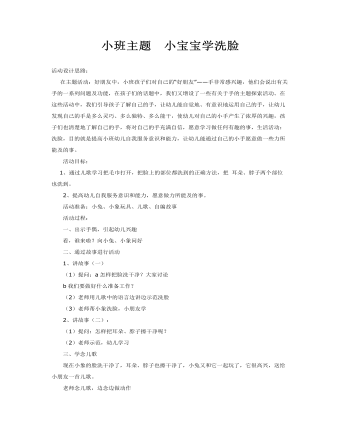
小班主题 小宝宝学洗脸课件教案
活动目标: 1、通过儿歌学习把毛巾打开,把脸上的部位都洗到的正确方法,把耳朵、脖子两个部位也洗到。2、提高幼儿自我服务意识和能力,愿意做力所能及的事。 活动准备:小兔、小象玩具、儿歌、自编故事 活动过程: 一、出示手偶,引起幼儿兴趣 看,谁来啦?向小兔、小象问好 二、通过故事进行活动1、讲故事(一) (1)提问:a怎样把脸洗干净?大家讨论b我们要做好什么准备工作?









